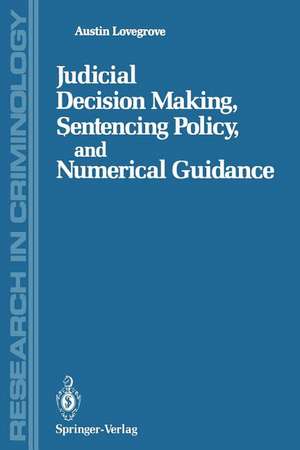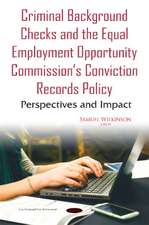Judicial Decision Making, Sentencing Policy, and Numerical Guidance: Research in Criminology
Autor Austin Lovegroveen Limba Engleză Paperback – 6 apr 2012
Din seria Research in Criminology
- 15%
 Preț: 639.41 lei
Preț: 639.41 lei -
 Preț: 384.70 lei
Preț: 384.70 lei -
 Preț: 380.07 lei
Preț: 380.07 lei -
 Preț: 381.43 lei
Preț: 381.43 lei - 15%
 Preț: 635.31 lei
Preț: 635.31 lei - 15%
 Preț: 633.19 lei
Preț: 633.19 lei - 18%
 Preț: 958.38 lei
Preț: 958.38 lei - 5%
 Preț: 712.81 lei
Preț: 712.81 lei -
 Preț: 384.09 lei
Preț: 384.09 lei -
 Preț: 384.86 lei
Preț: 384.86 lei -
 Preț: 379.48 lei
Preț: 379.48 lei -
 Preț: 384.86 lei
Preț: 384.86 lei -
 Preț: 380.07 lei
Preț: 380.07 lei -
 Preț: 378.54 lei
Preț: 378.54 lei -
 Preț: 390.84 lei
Preț: 390.84 lei -
 Preț: 383.50 lei
Preț: 383.50 lei -
 Preț: 398.74 lei
Preț: 398.74 lei -
 Preț: 383.93 lei
Preț: 383.93 lei -
 Preț: 387.38 lei
Preț: 387.38 lei
Preț: 390.46 lei
Nou
Puncte Express: 586
Preț estimativ în valută:
74.72€ • 81.14$ • 62.77£
74.72€ • 81.14$ • 62.77£
Carte tipărită la comandă
Livrare economică 23 aprilie-07 mai
Preluare comenzi: 021 569.72.76
Specificații
ISBN-13: 9781468470826
ISBN-10: 1468470825
Pagini: 336
Ilustrații: XII, 320 p.
Dimensiuni: 155 x 235 x 18 mm
Greutate: 0.47 kg
Ediția:Softcover reprint of the original 1st ed. 1989
Editura: Springer
Colecția Springer
Seria Research in Criminology
Locul publicării:New York, NY, United States
ISBN-10: 1468470825
Pagini: 336
Ilustrații: XII, 320 p.
Dimensiuni: 155 x 235 x 18 mm
Greutate: 0.47 kg
Ediția:Softcover reprint of the original 1st ed. 1989
Editura: Springer
Colecția Springer
Seria Research in Criminology
Locul publicării:New York, NY, United States
Public țintă
ResearchCuprins
One A Perspective for a Quantitative Approach to Sentencing Policy and Guidance.- 1 The Task of Describing Sentencing Policy Quantitatively.- 2 Approaches to the Development of Detailed Sentencing Statistics and Numerical Guidelines.- 3 Toward a Model of Judicial Decision Making: An Unproductive Review of Psychological Research.- Two An Archival Study of a Legal Model of Judicial Decision Making in Sentencing.- 4 A Legal Model of Judicial Decision Making.- 5 The Data Base and Data Collection.- 6 Offense Characteristics of Burglary.- 7 The Relationship Between Offense Characteristics of Burglary and Sentence.- 8 Offender Characteristics and Prior Convictions in Cases of Burglary.- 9 The Relationship Between Offender Characteristics of Burglary and Sentence.- 10 The Relationship Between Case (Offense and Offender) Characteristics of Burglary and Sentence.- 11 Toward Detailed Sentencing Statistics.- Three Sentencing Policy and Numerical Guidance as a Deliberative Process.- 12 Judicial Input Into the Model of Sentencing.- 13 The Validity of the Technique of Fictitious Cases.- 14 Multiattribute Utility Measurement and the Model of Judicial Decision Making.- 15 Scaling of Seriousness and Assessment of Weights for Offense Factors of Burglary.- 16 Coherence and the Tariff.- 17 Toward Deliberative Sentencing and Numerical Guidelines.- Appendix 1 A Sample Case in Exercise 1.- New Case.- Appendix 2 A Sample Fictitious Case in Exercise 3 and Exercise 4.- New Case.- References.- Author Index.










